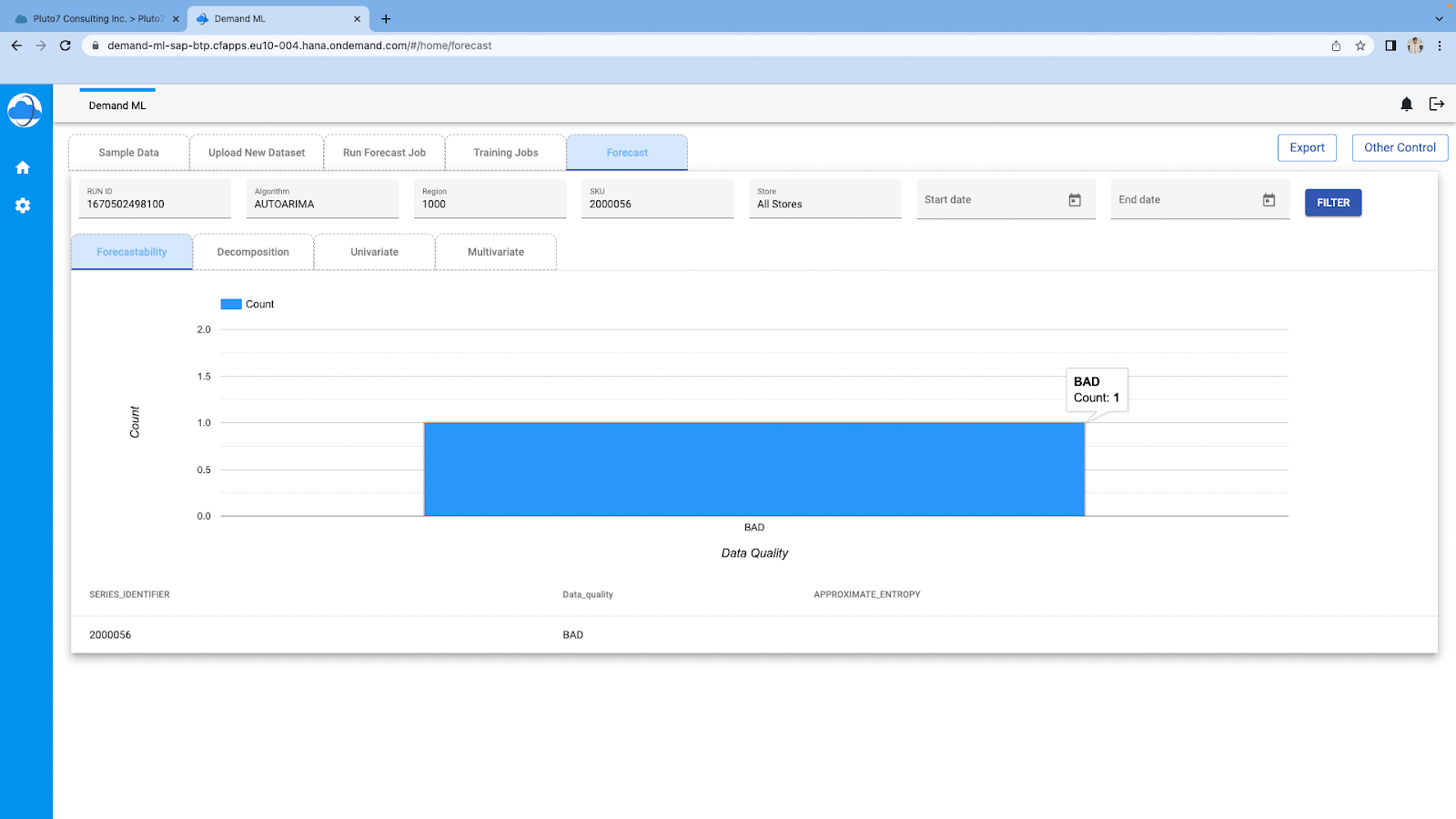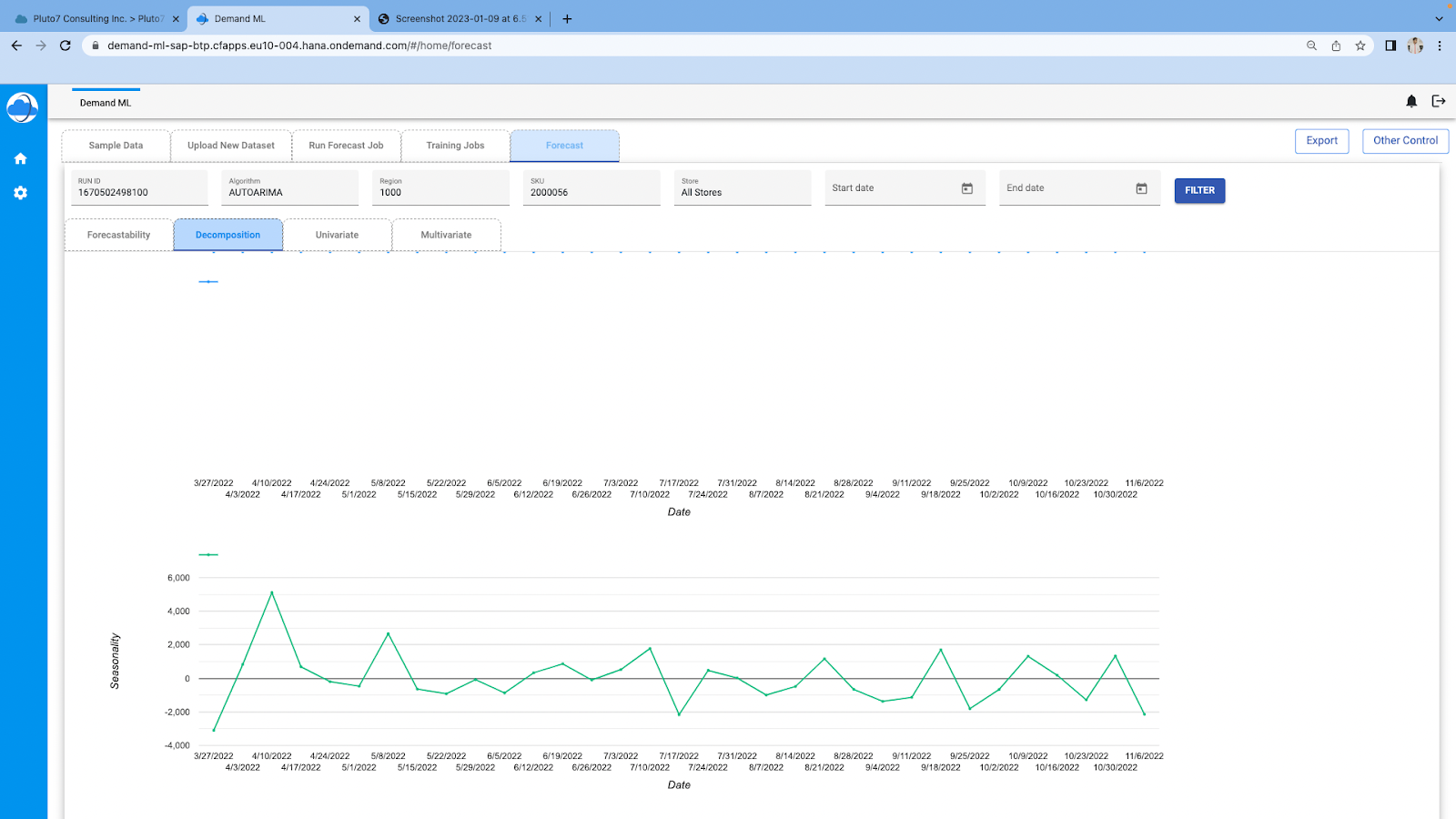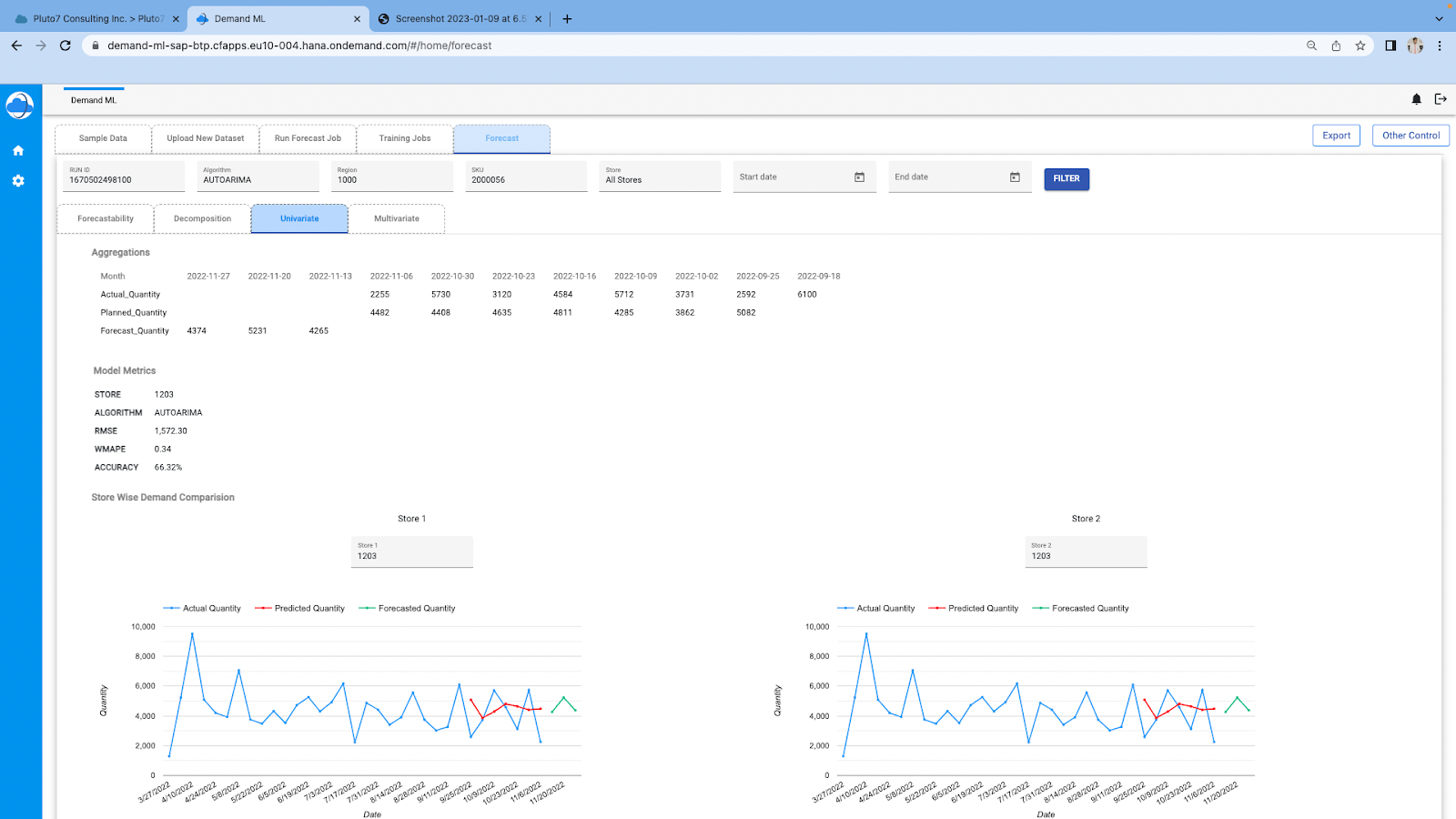
Transform Your Supply Chain Planning and Marketing Strategies with Google Cloud and SAP Integration

Transform Your Supply Chain Planning and Marketing Strategies with Google Cloud and SAP Integration
June 26, 2023 | Manju Devadas
Blog / Pushing Boundaries in Demand Planning: The Power of SAP IBP and Google Cloud
Within the world of demand planning, SAP Integrated Business Planning (SAP IBP) has earned its reputation as a reliable solution. It processes internal historical data efficiently, but as we step into an increasingly volatile business landscape, new complexities emerge.
Addressing these concerns head-on is Pluto7’s Demand ML, a tool designed in collaboration with SAP and powered by Google Cloud. It brings in over 250 external demand signals into SAP IBP, thereby broadening its forecasting perspective. It also uses Generative AI and LLM to make the process of analysis faster and more efficient. Moreover, Demand ML simplifies data engineering tasks, thus making it easier to implement and use.
This whitepaper will delve into how Demand ML enhances SAP IBP’s capabilities and provides an efficient, comprehensive solution to the challenges stated above. It aims to empower supply chain analysts, leaders, demand planners, and CIOs with critical knowledge and strategies to navigate the intricate landscape of modern demand planning.
Demand ML is a ready-to-deploy solution by Pluto7, hosted on the SAP Business Technology Platform and Google Cloud. It uses machine learning to enhance demand forecasting and inventory management. By integrating with systems like SAP IBP and leveraging external datasets, Demand ML provides deeper insights and more accurate demand predictions.
One of the key strengths of this technology lies in the unique blend of Datasphere and BigQuery architecture. This enables enterprises to seamlessly integrate data from an extensive range of SAP solutions, including ECC, S4HANA, IBP, Ariba, SuccessFactors, and other SAP Line of Business products. Simultaneously, it leverages Google Cloud’s BigQuery to incorporate second and third-party data. The overarching goal here is to empower enterprises to focus on discerning critical data sources that significantly impact their business operations rather than the technical intricacies of data ingestion and modeling.
This architecture taps into a range of state-of-the-art engineering capabilities from SAP and Google Cloud, promising multiple benefits:
Data Federation
The interplay between Datasphere and BigQuery bypasses conventional data copying or moving procedures, substantially reducing data latency and ensuring data integrity. This enhancement significantly optimizes performance and cost-efficiency by eliminating the need for additional computational resources.
Scalability and Speed
Datasphere and BigQuery can handle petabytes of data and process this information in a matter of seconds.
Customized AI Algorithms
Google Cloud’s Vertex AI platform hosts robust predictive and generative AI algorithms, which are tailored and optimized by Pluto7 based on enterprise data.
Native Integrations
Built by SAP and Google, these integrations can ingest data from virtually any data source in real time or in batches.
Blend Multiple Data Sources
The technology enables the easy integration of data from various sources, either in Datasphere, BigQuery, or both.
ML Ops Capabilities
Strong and secure operations ensure that models are continually updated, trained, and learning from the most recent data.
Visualization
ML forecasts can be visualized in the user interface of choice, including SAP Analytics Cloud, Looker, Power BI, or Pluto7’s Demand ML application. This offers instantly actionable intelligence within the familiar SAP ecosystem.
Transparent AI Code
Thanks to the Glassbox methodology, enterprises can enjoy full visibility and access to the ML/AI code, a distinct shift from SAS-based architectures which often offer limited access to AI algorithms and code.

To determine the best model for forecasting, it’s crucial to understand the nature of your data. Is it seasonal? Is there a trend? How volatile is it? Pluto7’s Demand ML solution on SAP BTP can automatically analyze the data to answer these questions.

Consider a large supermarket chain operating across different regions, dealing with thousands of SKUs ranging from fresh produce to household items. The sales patterns of these diverse items can be affected by several factors like seasonality, regional preferences, promotional campaigns, and unexpected events like a pandemic or a weather crisis. Hence, data forecastability becomes paramount to managing such complex scenarios effectively and optimizing inventory across different stores.
Here’s how Pluto7’s Demand ML solution on SAP BTP can support this supermarket chain:
Seasonality: Using these tools, the supermarket chain can identify recurrent patterns over certain periods. For instance, it might recognize increased sales of barbecue-related products during the summer months or heightened demand for baking ingredients during the holiday seasons.
Trend: The analysis might highlight a steady rise in organic product sales or an increasing preference for online orders, providing valuable insights for long-term strategic planning and decisions.
Volatility: This refers to the fluctuation in sales data, which could be high due to changing consumer trends, regional events, or sudden disruptions. For instance, a severe weather event might cause a spike in the demand for emergency supplies like batteries and bottled water.
By integrating Google Cloud and Pluto7’s Demand ML solution with SAP IBP, the supermarket chain can sharpen its demand forecasting. This results in better alignment of inventory with anticipated demand, more effective management of supply chain for items with high volatility, and enhanced customer satisfaction through ensured product availability.

Data decomposition can greatly help users of SAP Integrated Business Planning (IBP) understand complex sales patterns for more accurate forecasting. Leveraging Google Cloud’s advanced analytics capabilities in combination with SAP IBP can simplify this process, allowing users to break down their data efficiently and gain valuable insights.

Consider a manufacturing company that uses SAP IBP for its inventory planning. The company has to navigate fluctuating sales trends due to various factors such as seasonal changes, new product releases, promotional events, and market unpredictability. This could make demand forecasting quite challenging.
Data decomposition becomes a vital tool in such scenarios. By leveraging Google Cloud’s Vertex AI capabilities in conjunction with SAP IBP, the manufacturing company can decompose its sales data into several key components:
Trend: This reveals the long-term progression of sales, showing if there’s consistent growth, a decline, or a plateau over time.
Seasonality: This uncovers recurring short-term patterns in the data. For instance, it might show increased sales during particular seasons or around specific events like product launches.
Residuals: These are the unexplainable fluctuations in the sales data once the trend and seasonality have been accounted for. They could be due to unforeseen market events or abrupt changes in consumer behavior.
Understanding these components allows the manufacturing company to tailor their demand planning within SAP IBP. They can better align inventory management and production schedules with the identified trends and seasonal patterns. Additionally, they can create contingency plans to handle unexpected sales fluctuations (residuals).

Univariate forecasting is a statistical method that uses a single variable, such as time, to predict future data based on historical patterns. This methodology is particularly beneficial when the data shows a consistent pattern over time, with minimal influence from external variables.
However, in practice, generating a reliable univariate forecast can be a challenging task for SAP IBP users due to multiple reasons. Firstly, there’s the issue of data quality: historical data might be missing, incomplete, or inconsistent, leading to inaccurate predictions. Secondly, the inherent simplicity of univariate models can be a double-edged sword. While they are easy to understand and implement, these models may oversimplify complex scenarios, especially in today’s dynamic and unpredictable business environment.

Imagine a pharmaceutical company that operates multiple manufacturing facilities across different countries. This company produces several different drugs, each with its own unique production cycle and demand pattern.
Using SAP IBP alone, the company might struggle with producing accurate forecasts for each product line. The sales patterns might be influenced by numerous external factors such as global health trends, regulatory changes, or market competition.
By leveraging univariate forecasting through Pluto7’s Demand ML on SAP BTP, the pharmaceutical company can create accurate production forecasts based on historical data. Here’s how it works:
Data Quality Improvement: Pluto7’s Demand ML can help cleanse and harmonize historical data, filling in gaps and removing inconsistencies.
Trend Detection: The solution can identify consistent patterns and trends in production volumes over time. For instance, it might recognize that production typically ramps up in Q3 in anticipation of flu season.
Forecast Generation: Based on these trends, the solution generates accurate forecasts, providing the production team with valuable insights for scheduling and resource allocation.
Continuous Improvement: As the model is exposed to more data over time, it learns and improves, leading to even more accurate forecasts in the future.

While univariate forecasting captures the relationship between a single variable and time, multivariate forecasting broadens the scope to capture intricate correlations between multiple variables. This creates a more refined forecast, essential for handling intricate situations where numerous factors simultaneously affect the business.
In the context of SAP IBP, achieving such multivariate forecasting sophistication could present hurdles. The task may turn into a complex effort, given the large volumes of data and computational power needed. Additionally, the challenge of selecting the right blend of variables to capture the true essence of business dynamics calls for deep domain knowledge and analytical prowess. Moreover, distilling meaningful insights from multivariate analysis often requires a nuanced understanding of how variables intertwine and influence each other.

Consider a multinational electronics manufacturer with a wide array of product lines spanning various regions worldwide. The company’s sales are subject to a multitude of influencing factors – lifecycle stages of products, regional economic health, competitive pressure, marketing initiatives, and much more.
If the manufacturer solely relied on SAP IBP, creating accurate sales forecasts considering this diverse array of influences might be a daunting task. However, with multivariate forecasting, the manufacturer can significantly enhance forecast accuracy and strategic business planning.
Here’s the potential course of action:
Integrating external datasets for informed decision-making can dramatically increase the accuracy of forecasts in today’s data-rich environment. However, SAP IBP users often face challenges when it comes to blending this external data with their existing data structures. This might stem from different data formats, inconsistent data quality, and the complexity of integrating disparate data sources, often requiring a significant amount of time and specialized expertise.
This is where Google Cloud Cortex, a data fabric solution, plays a crucial role by creating a unified layer of data across different sources, simplifying data management. It helps cleanse, transform, and integrate different data types into a consistent, analysis-ready format, thereby making it accessible and useful for decision-making.
When this is coupled with Pluto7’s Demand ML solution on the SAP Business Technology Platform (BTP) and integrated with SAP Integrated Business Planning (IBP), users gain access to a vast array of data sources, offering enhanced decision-making capabilities.
External data blending can prove to be a game-changer for industries across the board. Some of the most widely used datasets include:
Weather Data: This dataset includes information about various weather conditions like temperature, humidity, rainfall, wind speed, and more, often recorded hourly and available for different geographical locations worldwide.
Consumer Price Index (CPI): The CPI is a measure that examines the average prices of a basket of consumer goods and services, such as transportation, food, and medical care. It’s one of the most frequently used statistics for identifying periods of inflation or deflation. Thus, it’s a crucial dataset that can forecast shifts in purchasing power affecting overall retail sales.
Google Analytics: This dataset provides detailed statistics about a website’s traffic and traffic sources and measures conversions and sales. It’s the most widely used website statistics service and offers insights into customers’ online behavior, which can aid in predicting online sales more accurately.
Google Trends: This dataset represents the popularity of top search queries in Google Search across various regions and languages. It allows users to see the search volume relative to the total search volume across various regions of the world or in a specific country, making it a powerful tool for forecasting demand spikes or drops.
Social Media Sentiment Data: This dataset provides a rich source of unstructured data, reflecting public opinion and sentiments about brands, products, or events. By analyzing this data, companies can gain insights into customer sentiment and trends, which is crucial in predicting the demand for new product launches or assessing the impact of marketing campaigns.
Macro Economic Indicators: These datasets provide information on broad economic phenomena, like GDP, employment rate, interest rates, and more. These macroeconomic indicators enable businesses to adjust their strategies accordingly in anticipation of economic shifts.
While the range of external datasets available is wide, it’s rare to find solution accelerators that effectively leverage them to solve intricate supply chain issues. Pluto7’s Demand ML solution on SAP Business Technology Platform (BTP) excels precisely in this area – bridging the gap between external public datasets and internal ERP and CRM data for more connected, intelligent, and responsive supply chain planning.

Consider a leading Consumer Packaged Goods (CPG) company that specializes in ice cream products. As a seasonally affected business, understanding changing consumer interests in real-time is paramount to the brand. In this regard, external demand signals like Googe Trends can be a game-changer.
Using Pluto7’s Demand ML solution on SAP BTP, the ice cream brand integrates Google Trends data to monitor search volumes for keywords related to their products, specific ice cream flavors, or even general ice cream trends. These trends in search data allow the brand to stay on top of consumer interest shifts in different flavors or types of ice cream.
This real-time insight has multiple effects on their operations:
As businesses increasingly recognize the potential of AI and Machine Learning (ML) to drive insights and improve decision-making, integrating these advanced technologies into existing enterprise systems has become a top priority. For SAP users, the challenge lies in seamlessly merging SAP’s robust functionality with the innovative capabilities of Google Cloud.
To address this, we have developed intelligent data platform solutions that not only simplify the integration but also automate and enhance various aspects of the ML implementation process.
Here’s how our data platform solutions can bring the best of Google Cloud to SAP users, streamline the AI and ML implementation roadmap, and revolutionize the way businesses leverage data for actionable insights and optimized performance.
In 2023 and beyond, these integrated solutions will be instrumental in mastering supply chain complexities, from demand sensing to inventory management. As we delve further into the age of data, unifying these platforms to create robust, adaptable, and intelligent supply chains will become less of an option and more of a business imperative.
We invite you to reach out to Pluto7 and explore the potential of our Demand ML solution for your organization. Step into the future of supply chain management with us. Let’s unlock new possibilities together.
Pluto7 is a Google Cloud Premier Partner, delivering data platform solutions to transform business operations. With a strong focus on supply chain and manufacturing, Pluto7 leverages Google Cloud’s AI, ML, and analytics solutions to solve critical business problems. Our ready-to-deploy solutions, including the Demand ML on the SAP Business Technology Platform, offer innovative ways to drive efficiency, optimize costs, and unlock new business opportunities. We are committed to helping businesses realize the true potential of their data and accelerate their journey toward digital transformation.
ABOUT THE AUTHOR